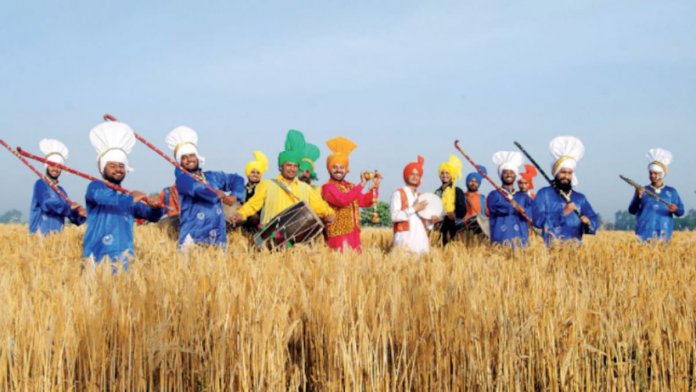Earlier, we studied about the cultural, geographical and political aspects of Punjab. If you haven’t read that already, click here – Know your State ‘Punjab’ – Part 1. In this blog, we’ll discuss history, environment and economy of Punjab.
What was the chronicle contribution of Punjab in Indian history? From which state Himachal Pradesh and Haryana craved out?
Punjab is the yellow land of rivers that has unmatched beauty, situated on the north-western edge of India. Punjab is one of the prosperous states of the nation, and home to a lively, hospitable and dynamic population.
Now, we’ll discuss the history of Punjab.
Table of Contents
Punjab HISTORY Notes:
Punjab is the place where the first civilization of South Asia flourished around 2500 BC. The state was an ancient center of settlement in the Indian Subcontinent.
Before Independence
- The endowment of Punjab was put down by Banda Singh Bahadur. The defeat of Banda Singh was followed by a struggle. The Sikhs on one side fought against the Mughals and Afghans on the other in 1716.
- The Sikhs had built their supremacy in the state. Ranjit Singh subsequently established the Punjab area into a powerful Sikh kingdom and attached to it the adjacent provinces of Multan, Kashmir, and Peshawar.
- The Punjab state cut down to the troops of the British East India Company and later became a territory under British rule in 1849.
- By the late 19th century, one of the most significant events linked with the movement was the Massacre of Amritsar famously known as Jallianwala Bagh Massacre, 1919 that was to fire on a group of some 10,000 Indians who had convened to protest against the new anti-subversion regulations enacted by the British administration resulted from an order given by the British General Reginald Edward Harry Dyer.
- When India gained its independence in 1947, the British province of Punjab was split between the new sovereign states of India and Pakistan.
Post Independence
- After independence, the history of the Indian Punjab was dominated by Sikh concerns for a separate Punjabi-speaking state. This was led by Tara Singh.
- In November 1956, rather than being divided on the basis of linguistic lines, the Indian state of Punjab was enlarged through the incorporation of the Patiala and East Punjab States Union (PEPSU) which was an amalgamation of the pre-independence princely territories of Patiala, Jind, Nabha, Faridkot, Kapurthala, Kalsia, Malerkotla and Nalagarh.
- Punjab was divided on the basis of language into the mostly Hindi-speaking state of Haryana and the new, primarily Punjabi-speaking state of Punjab and the northernmost districts were transferred to Himachal Pradesh and the newly constructed city of Chandigarh became a separate union territory on 1 November, 1966.
- The city of Chandigarh was retained as the joint administrative headquarters of both Haryana and Punjab though not a part of either state.
- In the 1970s and 1980s, the Khalistan movement or the Sikh Separatist movement reached its prominence. However, Operation Blue Star was conducted by the Indian Army in which many Sikh militants were killed and prisoned. Jarnail Singh Bhindranwale was held accountable for launching the Sikh militancy during the 1980s. This operation led to the assassination of the then Prime Minister of India, Mrs Indira Gandhi.
Let’s study the environmental aspects of Punjab.
Punjab ENVIRONMENT Notes:
Punjab is the Land of Five Rivers, bestowed with the beauty of nature as well as a rich culture. Punjab is a beautiful place that has been blessed with fertile lands and picturesque landscapes. Besides these lush, fertile farms makes it one of India’s prettiest states.
- The five major rivers of Punjab are Sutlej, Beas, Ravi, Chenab, and Jhelum. Only Sutlej, Ravi and Beas rivers flow in today’s Punjab. The other two rivers are now in the state of Punjab, situated in Pakistan.
- These five rivers that drain the fertile lands of Punjab have their origin from various small lakes in the mighty Himalayas.
- Mainly there are 3 popular dams in Punjab are: Ranjit Sagar Dam, Shahpur Kandi Dam, Shanan Power House.
- The Ranjit Sagar Dam, which is locally known as the Thein Dam, has the largest diameter penstock pipes in the country and one of the highest earth-fill dams in India.
- Punjab is primarily an agricultural state, with 83% of the total geographical area under agriculture. Punjab has only 6.12% of the area i.e. 3084 Sq. kilometers in which Reserve Forest is 44 Sq. Km., Unclassed Forest is 1903 Sq. Km.
- Total number of Wildlife Sanctuaries in Punjab is 13. These are some famous wildlife sanctuaries are Abohar Wildlife Sanctuary, Harike Wildlife Sanctuary, Jhajjar Bacholi. Wildlife Sanctuary, Bir Moti Bagh Wildlife Sanctuary, Bir Bhadson Wildlife Sanctuary. There are no National Parks in Punjab.
Moving further, let’s talk about the economy of the state.
Punjab ECONOMY Notes:
The economy of Punjab is the 14th-largest state economy in India. Punjab’s economy has been primarily agriculture-based since the Green Revolution due to the presence of abundant water sources and fertile soils. The two-fifths of Punjab’s population are engaged in the agricultural sector, which accounts for a significant segment of the state’s gross product. Punjab produces a significant portion of India’s food grain and contributes a major share of the wheat and rice stock held by the Central Pool hence Punjab is known as India’s bread basket. As the state lacks fossil fuels, Punjab draws its energy primarily from thermal plants fired with imported coal. Punjab’s services sector includes trade, transportation and storage, financial services, real estate, public administration, and other services. The sector has grown rapidly since the late 20th century.
GDP: ₹6.44 lakh crore
Rank (as per GDP): 14th
Growth of GDP: 6.0% (2018-19)
Per capita GDP: ₹154,996 (2018-19)
Rank (per capita GDP): 15th
GDP by sector: Agriculture- 25%, Industry- 25%, Services- 50% (2018-19)
Unemployment: 7.8% (2017-18)
Punjab EDUCATION Notes:
Private organizations have played a significant role in the extension of education at the primary, secondary, and tertiary levels throughout the state along with the government. Education is compulsory and free for students aged 6 to 11. Secondary education is also free in state schools. Punjab has several state universities, including Punjabi University in Patiala, Guru Nanak Dev University in Amritsar, Panjab University in Chandigarh, Punjab Agricultural University in Ludhiana, Punjab Technical University in Jalandhar, and Baba Farid University of Health Sciences in Faridkot. In addition, there are more than 200 specialized colleges and technical institutions.
Punjab SPORTS Notes:
Kabaddi is the state sport of Punjab. There are over 100 traditional games and sports of Punjab. Punjabis play a wide variety of sports and games, ranging from modern games such as hockey and cricket, to the more traditional games such as kabaddi, wrestling and hockey.
Some more interesting facts about Punjab:
- The Golden Temple or Shri Harmandir Sahib in Amritsar, Punjab which is known as the holiest place and important pilgrimage site of Sikhism is the world’s most visited place in India as per the world book of records
- Takshashila is India’s one of the oldest universities situated in Punjab.
- Punjab has one of the best-developed road networks in the country. All-weather paved roads extend to most villages, and the state is crossed by a number of national highways.
- Trigarta means three pits, was the older name of Punjab during Mahabharata.
Therefore, these were all the chief necessitate facts about Punjab that will help in your preparation for competitive exams like SSC CGL, CDS, Civil Services and NDA etc.
Conclusion
Also Check Punjab Culture, History, Geography Notes
In the next blog, we would be discussing some interesting facts and trivia about the state of Rajasthan. Click here for Know your State – ‘Rajasthan’.
We would recommend that you check out our other interesting blogs about the state of Haryana Culutre, Geography Notes , and the Union Territories of Chandigarh and Delhi as well.
THANK YOU
The Indian State of Punjab was created in 1947, when the partition of India split the former Raj province of Punjab between India and Pakistan. The mostly Muslim western part of the province became Pakistan’s Punjab Province; the mostly Sikh eastern part became India’s Punjab state.
Punjab has one of the oldest and richest cultures of the world. Its diversity and uniqueness is evident in the Punjabi poetry, philosophy, spirituality, education, artistry, music, cuisine, science, technology, military warfare, architecture, traditions, values and history.
Banda Singh Bahadur
Sapta Sindhu
Maharaja Ranjit Singh: The Lion of the Punjab.
Lala Lajpat Rai (28 January 1865 — 17 November 1928)
Punjabi emerged as an Apabhramsha, a degenerated form of Prakrit, in the 7th century CE and became stable by the 10th century. The earliest writings in Punjabi belong to Nath Yogi era from 9th to 14th century CE.




